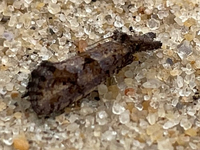Identification
Adult Markings: This is a relatively small species of Acrolophus that is similar in size to A. piger and A. forbesi . The head is rough with brownish scales and the bushy, labial palp of the male is recurved over the head. It extends onto the thorax, but terminates before reaching the posterior edge. The second joint is very long and roughly clothed with projecting scales beneath. The third joint is about half as long as the second, brushlike, and with very long diverging scales. The antenna is slightly pubescent and simple, but may appear to be somewhat serrated on both sides. The forewing has alternating brown and whitish ocherous patches, with the brown patches taking the form of two angulated bands. Raised bluish-fuscous scales are scattered throughout, but especially in the darker patches (Hasbrouck, 1964). The hindwing and cilia are dull brown. Females have prominent palps that project forward. This species is similar to A. cressoni , but is smaller and the labial palps extend onto the thorax.
Wingspan: 15 mm (Hasbrouck, 1964)
Adult Structural Features: Hasbrouck (1964) has descriptions and illustrations of the male genitalia. The male antenna is simple but appear somewhat serrate due to rings of slightly elevated scales that completely encircle each segment. The eyes are setose, and the uncus has a single process that is minutely and acutely bifid at the extreme apex. This species can be distinguished from the closely related A. bicornutus by the shape of the cucullus and in the number of cornuti in the aedeagus (Hasbrouck, 1964).
Genitalia and other structural photos
Adult ID Requirements: Identifiable from photos showing hindwings, abdomen, or other specialized views [e.g., frons, palps, antennae, undersides].
Immatures and Development: The life history of the larval stage is undocumented.
Larvae ID Requirements: Identifiable only through rearing to adulthood.

 »
»

 »
»